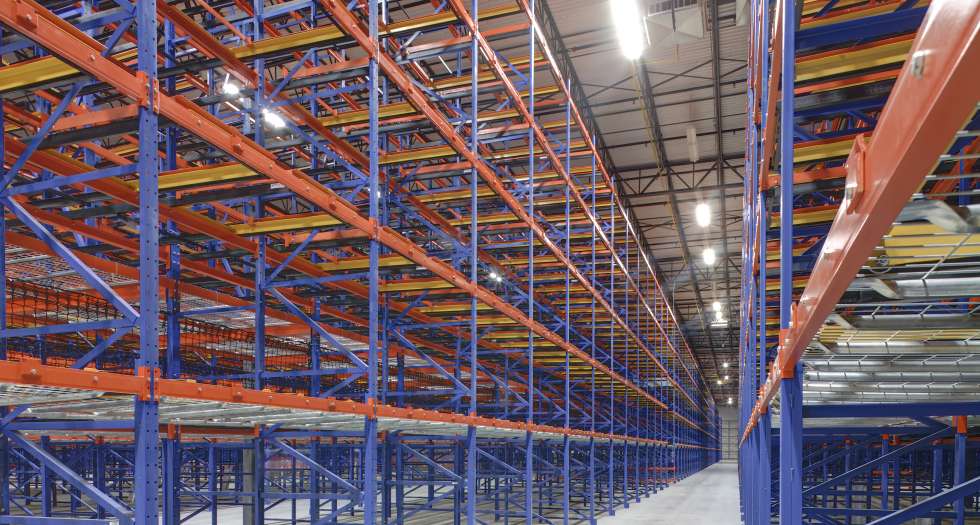There are many different types of pallet racking configurations that can be selected by end users depending on their storage needs. They range from low density selective rack all the way to high-density pushback , drive in, and pallet flow systems. Each configuration has advantages and disadvantages:
Selective Pallet Rack:
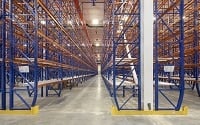 Single selective pallet rack is the most common style of rack system. It is low cost, readily available and provides access to every pallet. The down side is that nearly 50% of the facility is dedicated to aisle space (typically 9-12′) and density is sacrificed.
Single selective pallet rack is the most common style of rack system. It is low cost, readily available and provides access to every pallet. The down side is that nearly 50% of the facility is dedicated to aisle space (typically 9-12′) and density is sacrificed.
Narrow Aisle:
Narrow aisle rack is a variant of selective rack where the aisle is narrowed, typically to 60″. The aisles are accessed by a turret truck (or other narrow aisle style of truck) and still provide full selectivity. The rack investment is similar to selective rack, the specialized lift trucks are typically more expensive an operational efficiency is reduced because only a single vehicle can access the aisle at a time limiting the number of vehicles that can work in the facility at time. Narrow aisle (60″) can increase warehouse capacity by as much as 69% based on (10) 132″ selective aisles.
typically to 60″. The aisles are accessed by a turret truck (or other narrow aisle style of truck) and still provide full selectivity. The rack investment is similar to selective rack, the specialized lift trucks are typically more expensive an operational efficiency is reduced because only a single vehicle can access the aisle at a time limiting the number of vehicles that can work in the facility at time. Narrow aisle (60″) can increase warehouse capacity by as much as 69% based on (10) 132″ selective aisles.
Double Deep Reach:
 Double deep reach selective rack is another variant of selective rack where two racks are stood back to back and the rear pallet is accessed by a specialized lift truck with a pantograph that extends into the back of the rack. Double deep reach can increase warehouse capacity by as much as 72% based on (10) 132″ selective aisles. Pallets should be stored in pairs with the same product in both the front and back position. Double deep reach provides a nice increase in density when compared with selective, but requires specialty equipment and is slower to operate.
Double deep reach selective rack is another variant of selective rack where two racks are stood back to back and the rear pallet is accessed by a specialized lift truck with a pantograph that extends into the back of the rack. Double deep reach can increase warehouse capacity by as much as 72% based on (10) 132″ selective aisles. Pallets should be stored in pairs with the same product in both the front and back position. Double deep reach provides a nice increase in density when compared with selective, but requires specialty equipment and is slower to operate.
Pushback Rack:
A pushback system can provide from 2-6 deep storage, significantly 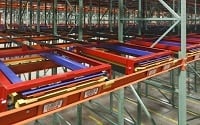 increasing density. Pallets are placed on carts located on a sloped rail system and “pushed back” by the lift truck operator. When removed, gravity brings the pallets back to the aisle. Pushback systems can increase density up to 75% when compared with a selective system. The downside to pushback is that since it is most effective to storage the same SKU in a single lane, and it is a LIFO style, lanes must be fully emptied to maintain proper production rotation. As a rule of thumb, there must be 4 times the depth of the lane in pallets for efficient storage (for a 5 deep system at least 20 of the same pallet).
increasing density. Pallets are placed on carts located on a sloped rail system and “pushed back” by the lift truck operator. When removed, gravity brings the pallets back to the aisle. Pushback systems can increase density up to 75% when compared with a selective system. The downside to pushback is that since it is most effective to storage the same SKU in a single lane, and it is a LIFO style, lanes must be fully emptied to maintain proper production rotation. As a rule of thumb, there must be 4 times the depth of the lane in pallets for efficient storage (for a 5 deep system at least 20 of the same pallet).
Drive In:
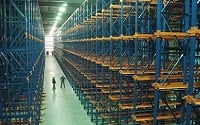 Drive in rack is another high density storage option in which the lift truck drives inside the storage rack and places the pallets on load rails. Drive in systems can range from 2 all the way up to 20 pallets deep. The systems are relatively inexpensive, but are limited due to lack of selectivity, low productivity and susceptible to damage. Used for Cold Storage, Food & Beverage and Grocery applications with limited SKU counts, limited product variation, date segregated production or batch production.
Drive in rack is another high density storage option in which the lift truck drives inside the storage rack and places the pallets on load rails. Drive in systems can range from 2 all the way up to 20 pallets deep. The systems are relatively inexpensive, but are limited due to lack of selectivity, low productivity and susceptible to damage. Used for Cold Storage, Food & Beverage and Grocery applications with limited SKU counts, limited product variation, date segregated production or batch production.
Two Wide Drive In:
Two wide drive in is a variant of drive in where lift trucks handle two pallets side by side at a time and place them concurrently on the load rails.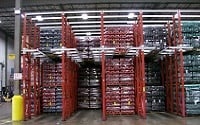 This is used for limited applications with low SKU and high volume applications. Can reduce the number of aisles, lower handling costs and increase loading and unloading time ideal for food & beverage or grocery applications.
This is used for limited applications with low SKU and high volume applications. Can reduce the number of aisles, lower handling costs and increase loading and unloading time ideal for food & beverage or grocery applications.
Pallet Flow:
In a pallet flow system the pallet is placed in the rear of the system on a 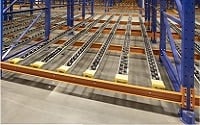 series of rollers, typically with a centrifugal braking system. The pallets roll forward by gravity to the front of the system providing FIFO storage. Pallet flow systems can range from 2-30 deep and provide very high density. They are typically the most expensive option, require good quality pallets and require more maintenance.
series of rollers, typically with a centrifugal braking system. The pallets roll forward by gravity to the front of the system providing FIFO storage. Pallet flow systems can range from 2-30 deep and provide very high density. They are typically the most expensive option, require good quality pallets and require more maintenance.
Modern facilities frequently make use of several different types of racking systems under the same roof to help customers optimize their storage space, while providing the right level of selectivity to match the mix and volume of SKU’s carried.

